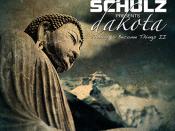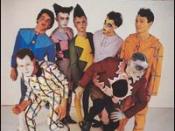The Pyrrhonians believed that all appearances and thoughts are in themselves necessarily inconsistent and unjustifiable. They believed that though we may be persuaded of the legitimacy of certain appearances by how consistently we perceive these appearances, were one to juxtapose these appearances and thoughts with others, we would find the inconsistency of any appearance or thought, and thereby require the suspension of judgment. The Pyrrhonians laid out ten modes (tropoi) which described the contradictions that our appearances rely upon in order to show the unjustifiability of our perceptions and thoughts. This would then lead to the requirement of the suspension of judgment.
1) The first mode describes the differences among animals as regards enjoyment and displeasure, harm and benefit. Hemlock may be nourishing and tasty for a quail, but it is fatal to a person. There is nothing "ontologically prior" and definite within the hemlock that would dictate whether or not hemlock is in itself harmful or beneficial to all creatures.
2) Because some things are harmful to some and beneficial to others, and some people may want to be farmers and others businessmen, the suspension of judgment must follow.
3) Sensory passages: an apple may be round and yellow and tasty, but the sun is also round and yellow but certainly not tasty. Therefore appearances cannot tell us the nature of an object.
4) Dispositions: Different people feel dispositions, such as satiety, emptiness, fear, courage, love, hate, differently. One can make no distinct and justifiable judgments in regard to how one experiences dispositions.
5) The fifth mode regards religious and mythical beliefs and customs. The Egyptians mummify their dead and the Romans cremate them. The Cilicians felt that piracy was honorable while the Greeks did not.
6) No thing appears to the senses completely by itself, colors and dependent upon and relative to the shades of light that engage with those colors; trees are heavy on land but light in the water. We will always remain ignorant of the properties of object because we can never distill those properties from their engagement with light, solidity, moisture, heat, cold, motion, etc.
7) At a distance, the sun appears smaller than it appears up close, such as from the standpoint of Mercury. All things are observed from a particular position and place and we can never look at an object without our position and place effecting the appearance of an object. This yet another reason that we can never know the nature of an object and thus must suspend judgment upon it.
8) The eighth mode regards quantities and qualities. When we drink wine moderately, it fortifies us and thins our blood, but when we drink wine to excess it weakens us. The same applies to food.
9) The ninth mode concerns those phenomena that appear rarely or intermittently and those phenomena that appear often or consistently. The sun appears almost everyday and thus occasions no wonder. Earthquakes rarely appear in Ohio, therefore evoking wonder, but they appear often in California, therefore evoking no wonder. There is nothing in the nature of the sun that necessarily occasions or does not occasion wonder, the same with earthquakes.
10) All things can also be thought of as in relation to other things. A boulder is large in comparison with a pebble but tiny in comparison with a mountain. Actions are virtuous only in relation to actions that are deplorable.
These ten modes seek to show the futility of attempting to make determinate judgments about anything. The mission of the Pyrrhonian sceptics was to suspend judgment on all objects and to display how this was the logically necessary way of thinking about our world.





